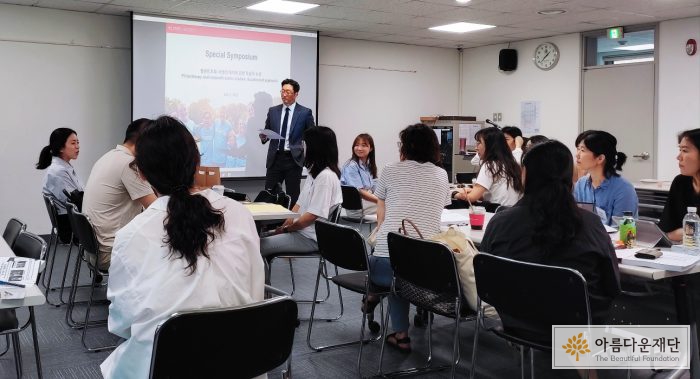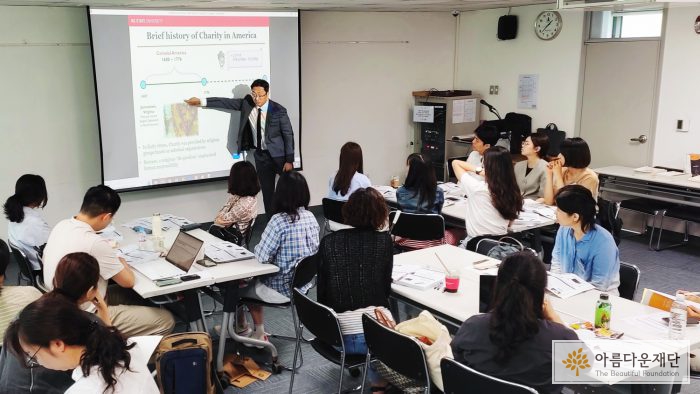On July 5th, Center on Philanthropy at The Beautiful Foundation conducted a seminar for researchers and those who work in NPOs. This one-day curriculum was organized based on philanthropy in the United States.
Chapter 1. What is “Philanthropy”?
Part 1 : Understanding the Difference Between Charity and Philanthropy Through American History
Part 2 : US Government Policy Changes to Revitalize Philanthropy
In the United States, the concept of “associational life” flexibly embraced all types of civic organizations in private social platforms, revealing a phenomenon in which non-profit organizations and civil societies develop philanthropic activities. In the early 19th century, charity was provided by religious groups, which were informal organizations, as religious ‘do-goodism’ emphasized human responsibility. Due to policy changes and events in the U.S. from 18th century to the present day, it has evolved from “charity” to “philanthropy.” Representatively, the scientific charity movement began in the late 19th century. Charity Organization Societies (COS) is a good example of a scientific charity movement. COS tried to apply scientific principles to the practice of charity, focusing on identifying and addressing the root causes of poverty and social problems. It was a significant event which emphasized the importance of data collection and analysis as well as the specialization and standardization of philanthropic activities. Since then, charitable donation related major law and policies have been continuously enacted and revised, which is similar to efforts to reduce policy changes whenever a new government enters to revive philanthropy. From the Bill Clinton administration to the current Biden administration, policies such as tax deductions were provided and changed in order to revitalize philanthropy. The direction of philanthropy-related policies has been changing since it follows the vision of each administration.
Chapter 2. Donation
Part 1 : Four Aspects of Donation : Who, Where to, Why, and How to give?
Part 2 : Measuring the size and scope of philanthropic giving.
Part 1 covers the importance of measuring the donation index, the countries where the donation index is measured, and the contents of research on major global donation indicators. Many countries measure the giving index to evaluate the social impact of donations, understand changes in donation trends, identify areas in need of support, and provide proper information for strategic decision-making. For instance, Giving USA provides comprehensive data on donations since 1956. As a result of analyzing donation-related studies, factors such as religion, educational level, and economic conditions have a significant effect on donation, and donation motives consist of eight major categories (recognition of necessity, altruism, reputation, psychological benefit, etc.). In order to promote donation, NPOs must keep strategizing, by considering donors’ motivation. There are several types of donations, which are individual donations, bequest donations, corporate donations, and donations from foundations. The donation index in each field is all differently measured. For example, since the design of a measurement tool is the very important when trying to accurately measure the giving index of individual donations, elements such as conceptual definitions of donations and survey units should be handled carefully.
Chapter 3. Non-profit Sector
Part 1 : Nonprofit Sector: Scope and Dimensions
Part 2 : Non-profit sector major conferences and major research areas
Professor Kim addressed a summary of terms related to non-profit sectors, an understanding of the 501(c) organization, and the composition and scale of non-profit sectors in Part 1, and major non-profit sector-related research and non-profit/philanthropy-related global conferences in Part 2. 501(c) organization refers to the tax law provisions regarding various types of tax-exempt organizations among the regulations of the US Internal Revenue Service according to the Tax Reform Act of 1969 mentioned above. It includes a total of 29 subcategories, meaning that the scope of tax deduction is wide. In addition, in non-profit sector of the States, approximately 1.54 million non-profit organizations are active, with 2.62 trillion USD in revenue and 2.5 trillion USD in expenses (as of 2016). It can be seen that the non-profit sector has a huge scale, accounting for 10.2% of private sector employment in the United States.
Part 2, the subject of major research related to the non-profit sector. The book <A Dictionary of Nonprofit Terms & Concepts> by David et al. summarizes terms used in nonprofit research. The authors classified the terms into general concept, non-profit political activity, association, volunteer, philanthropy, non-profit business, volunteer management, leisure, religion, and law.
In addition, to explain major research related to the non-profit sector, Professor Kim mentioned the non-profit sector research trend study (Ma & Konrah, 2018) as an example. This study shows how researchers has been contributing considerable efforts to develop non-profit sector as a new field of study for 30 years, establishing a solid intellectual foundation by publishing a number of papers. Based on this contribution, the scope of non-profit research has tremendously expanded after 1980s. Thanks to this, non-profit related research topics can be divided into several interconnected themes, and the research topics for each theme have become more diverse.
Through this seminar, the participants could learn about philanthropy-related policy changes in the U.S. and the non-profit sector in the United States, as well as how U.S. policies are active in philanthropy field. Korea should also refer to this and apply it appropriately to the circumstances, and it should actively help to develop strategies that meet the needs of donors. In addition, it will be easier to explore and search for the proper contents, and Korea’s philanthropy further expands if the concept of ‘philanthropy’ settle in Korea, and continuously conduct non-profit sector related academic research.


